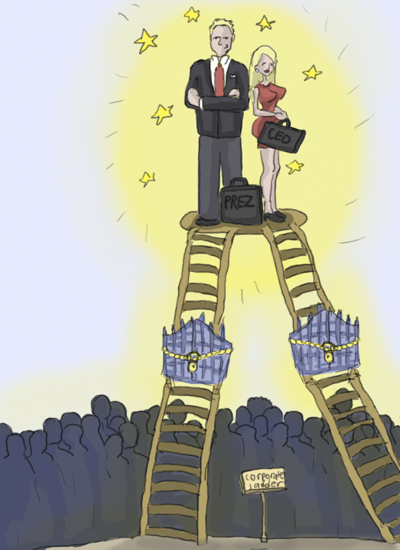A recent University of Florida study found that employees considered more attractive than their coworkers made larger salaries and rose higher up the corporate ladder than less good-looking employees. Though the study found that workers with the highest intelligence levels did the best overall in the workplace regardless of looks, the boost given to those considered better-looking was undeniable.
The quest for external beauty seems to have reached a frenzied climax in recent years, and the obsession with emulating the looks of the wealthy and glamorous has become a national fixation that has replaced far more significant and realistic endeavors.
What exactly do we consider beautiful? Plato wrote that the width of an ideal face would be two-thirds its length, and that the length of the nose would be no different than the distance between the eyes. Modern psychological studies have shown that participants respond in more favorable ways when presented with an image of a symmetrical face as opposed to a more asymmetrical one. When a natural proclivity becomes a public obsession, however, we find ourselves with the unnatural preoccupation seen today.
This obsession manifests itself in the ubiquitous unhealthy body images arising from unrealistic portrayals of anatomy. Especially among young women, this unhealthy obsession with becoming one of the “chosen ones” is manifesting itself in eating and exercise habits, with an estimated 65 percent of women ages 25-45 displaying disordered eating habits, according to a survey conducted by Self magazine in conjunction with the University of North Carolina at Chapel Hill.
We’re constantly surrounded by commercials and print ads that assert that beauty will bring you happiness. Look at any article in Cosmopolitan magazine ““ there’s a good chance that there is going to be some gorgeous, twig-like model in the embrace of her equally dashing lover.
“I think that the media tells us what to think, and their bias has become our bias,” said first-year international development studies student Amelia Noor.
I would be lying if I said that these influences have had no impact on me whatsoever. On a daily basis, I find myself in some shallow analysis of how I square up to any one of these models or celebrities. With the ordeal that bikini season is for many women, and, increasingly, young teenagers, I wouldn’t be the only one who has found herself limiting what she eats in order to get the “look.” Past articles in Girl’s Life magazine, aimed at a 10- to 15-year-old demographic, have included “Six Easy Moves to a Bikini Body” and “Summer Makeup Shades.” I was never even conscious of these things at 10 ““ I’m pretty sure Barbie was still a crucial part of my life at that point.
Though, come to think of it, Barbie is just another one of those manifestations of “ideal” beauty that surrounds us. Blond, blue-eyed, with no waist to speak of, she has become our Helen of Troy figure. A recent study from Sussex University and the University of the West of England found that young girls exposed to images of Barbie reported dissatisfaction with their own body proportions afterward.
With a distorted system of priorities conveyed to everyone, what value do brains have when pitted against beauty? According to our modern culture, none at all. Especially in a city like Los Angeles, social status and the success of one’s love life are contingent on pant size.
“We figure if the masses are thinking a certain way, an individual must think that way as well, and oftentimes, people don’t have the capacity to formulate their own opinion because of that,” Noor said. “Like every other person, I’ve had a struggle with confidence, but in the end, it’s not the media that’s going to approve of your appearance ““ it’s you.”
This risk of not being taken seriously, especially as a woman, is another potential side effect of emulating the “beautiful.” Secretary of State Hillary Clinton, for example, turned down an offer to be in Vogue in 2008 over a “fear of looking too feminine.”
Clinton’s all-male opponents did not have to worry about appearing vain and weak if they appeared in a magazine. It is assumed that, for women, appearance and competence are mutually exclusive.
For those who have the courage to transcend that ““ and I do not exaggerate with the word “courage” ““ genuine happiness with yourself seems attainable. If widespread change in perceptions is to occur, it likely will not manifest itself in a shift in media bias.
There will always be an emaciated Vogue model who is wearing the latest designs, romancing the best-looking lovers and probably making millions more than I could ever hope to. We will only be able to concentrate on matters that will actually have significant impact on our daily lives when we get over this disgusting hunger for unrealistic, Photoshopped beauty.
Until then, many women ““ my vain self included ““ will have to realize that looks will be overpowered by the brains of others if we decide to make the two mutually exclusive. You do not have to sacrifice one for the other, but a crazed concentration on the less crucial one will no doubt foment a shallow demise.
If you prefer to eat your meals rather than skip them, then e-mail Gharibian at cgharibian@media.ucla.edu. Send general comments to viewpoint@media.ucla.edu.
